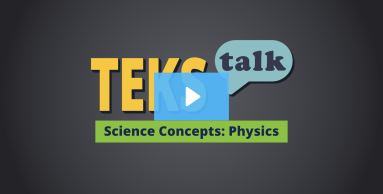- Science
- Grade 9
- Scientific and engineering practices
PHYS.1.G

Knowledge and Skills Statement
The further explanation is designed to be a resource for educators that helps them better understand the topic their students are learning. Further explanations may be written at a more complex level than would be expected for students at the grade level.
Models:
Both scientists and engineers use a variety of models. Physical models show how things look or work in the real world. Conceptual models represent relationships and describe how things work or fit together. Mathematical models use mathematical equations, theories, formulas, and proofs. Simulations allow for the control of variables and mimic real-world processes. Examples of models include sketches, diagrams, mathematical relationships, simulations, and physical models, and are used to make predictions about the behavior of a system.
Processes:
Natural processes such as life cycles, weather, or the rock cycle, can be represented with conceptual, physical, mathematical, or simulated models. In engineering, the solution to a design challenge could be a new or improved process shown with a model or diagram.
Prototype:
Prototypes are a subset of models that serve a specific purpose. Models are usually created after data is collected and are used to explain systems or processes. Models can be used to communicate findings to the target audience. Prototypes are usually created as an early step in determining why a system is not working or to try to improve a design. They are not typically shared with the broader public once the problem has been solved.
Research
Krajcik, Joseph, and Joi Merritt. “Engaging Students in Scientific Practices: What Does Constructing and Revising Models Look Like in the Science Classroom?: Understanding a Framework for K-12 Science Education.” The Science Teacher 79, no. 3 (2012): 10-13. https://static.nsta.org/ngss/resources/201203_Framework-KrajcikAndMerritt.pdf
